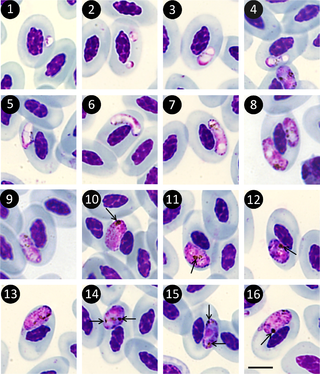
Plasmodium is a genus of unicellular eukaryotes that are obligate parasites of vertebrates and insects. The life cycles of Plasmodium species involve development in a blood-feeding insect host which then injects parasites into a vertebrate host during a blood meal. Parasites grow within a vertebrate body tissue before entering the bloodstream to infect red blood cells. The ensuing destruction of host red blood cells can result in malaria. During this infection, some parasites are picked up by a blood-feeding insect, continuing the life cycle.

The Plasmodiidae are a family of apicomplexan parasites, including the type genus Plasmodium, which is responsible for malaria. This family was erected in 1903 by Mesnil and is one of the four families in the order Haemospororida.
Isospora is a genus of internal parasites in the subclass Coccidia.
Plasmodium atheruri is a species of the genus Plasmodium subgenus Vinckeia. As in all members of this genus, it is parasitic on vertebrate and insect hosts. The natural vertebrate host is the African porcupine but it is possible to infect the large vesper mouse and Meriones unguiculatus.
Vinckeia is a subgenus of the genus Plasmodium — all of which are parasitic alveolates. The subgenus Vinckeia was created by Cyril Garnham in 1964 to accommodate the mammalian parasites other than those infecting the primates.
Hepatocystis vassali is a species of parasitic protozoa that infect mammals.
Dionisia is a genus of parasitic alveolates belonging to the phylum Apicomplexa.

The moustached guenon or moustached monkey is a species of primate in the family Cercopithecidae. It is found in Angola, Cameroon, Central African Republic, Republic of the Congo, Democratic Republic of the Congo, Equatorial Guinea, and Gabon.

Onchocerca is a genus of parasitic roundworm. It contains one human parasite – Onchocerca volvulus – which is responsible for the neglected disease Onchocerciasis, also known as "river blindness" because the infected humans tend to live near rivers where host black flies live. Over 40 million people are infected in Africa, Central America, and South America. Other species affect cattle, horses, etc.

Adeleorina is a suborder of parasites in the phylum Apicomplexa.

The Haemosporida are an order of intraerythrocytic parasitic alveolates.
Polychromophilus is a genus of obligate intracellular eukaryotic parasites that infect bats from every continent except Antarctica. They are transmitted by bat flies, which act as an insect vector as well as the parasite’s site of sporogeny. Polychromophilus follows a fairly typical Haemospororidian lifecycle, with gametocytes and gametes restricted to the bloodstream of the host and meronts infecting organs – most notably the lungs and the liver. The type species is Polychromophilus melanipherus, and was described by Dionisi in 1898.
Hepatocystis is a genus of parasites transmitted by midges of the genus Culicoides. Hosts include Old World primates, bats, hippopotamus and squirrels. This genus is not found in the New World. The genus was erected by Levaditi and Schoen, 1932, as Hepatocystes.
Hepatocystis bainae is a species of parasitic alveolates belonging to the phylum Apicomplexa
Hepatocystis carpenteri is a species of parasitic protozoa. They are transmitted by flies of the genus Culicoides and infect mammals.
Hepatocystis hipposideri is a species of parasitic protozoa. They are transmitted by flies of the genus Culicoides and infect mammals.
Hepatocystis muuli is a species of parasitic protozoa. They are transmitted by flies of the genus Culicoides and infect mammals.
Hepatocystis perronae is a species of parasitic protozoa. They are transmitted by flies of the genus Culicoides and infect mammals.
Hepatocystis epomophori is a species of parasitic protozoa. They are transmitted by flies of the genus Culicoides and infect mammals.
Allantocystis is a genus in the family Allantocystidae. Its only species is Allantocystis dasyhelei, a gregarine parasite of the larval biting midge Dasyhelea obscura.





